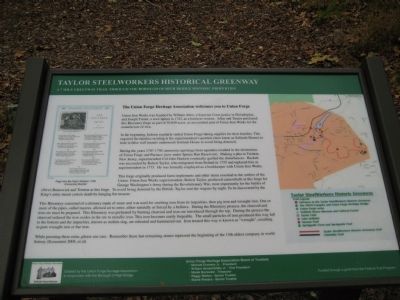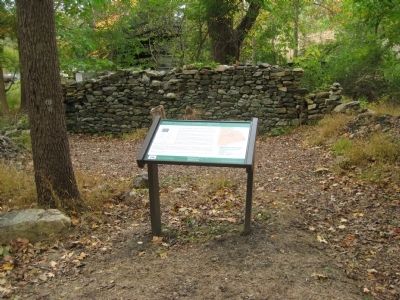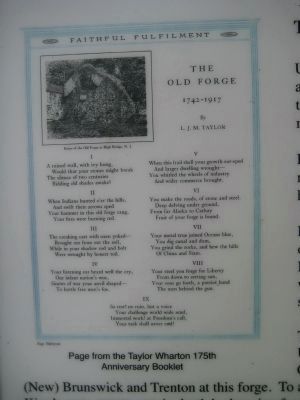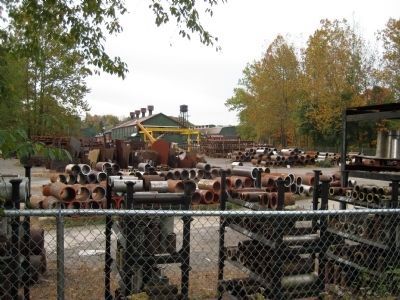High Bridge in Hunterdon County, New Jersey — The American Northeast (Mid-Atlantic)
Union Forge
Taylor Steelworkers Historical Greenway
— A 7 Mile Greenway Trail Through the Borough of High Bridge Historic Properties —
The Union Forge Heritage Association welcomes you to Union Forge
Union Iron Works was founded by William Allen, a Supreme Court justice in Philadelphia, and Joseph Turner, a sea Captain in 1742, as a business venture. Allen and Turner purchased this Bloomery forge as part of 10,849 acres, as an essential part of Union Iron Works for the manufacture of iron.
In the beginning, Indians regularly raided Union Forge taking supplies for their families. This required the families residing at the superintendent's quarters (now know as Solitude House) to hide in false wall tunnels underneath Solitude House to avoid being detected.
During the years 1747-1750, numerous uprisings from squatters resulted in the destruction of Union Forge and Furnace (now under Spruce Run Reservoir). Making a plea to Trenton, New Jersey, superintendent Col. John Hackett eventually quelled the disturbances. Hackett was succeeded by Robert Taylor, who emigrated from Ireland in 1755 and replaced him as superintendent in 1775. He was formally [formerly]employed as a bookkeeper with Union Iron Works.
The forge originally produced farm implements and other items essential to the settlers of the Union. Union Iron Works superintendent, Robert Taylor, produced cannonballs at this forge for George Washington's Army during the Revolutionary War, most importantly for the battles of (New) Brunswick and Trenton at this forge. To avoid being detected by the British, Taylor sent the wagons by night. To be discovered by the King's army meant certain death by hanging for treason.
This Bloomery consisted of a chimney made of stone and was used for smelting iron from its impurities, then pig iron and wrought iron. One or more of the pipes, called tuyeres, allowed air to enter, either naturally or forced by a bellows. During the Bloomery process, the charcoal and iron ore must be prepared. This Bloomery was preheated by burning charcoal and iron ore introduced through the top. During the process the charcoal reduced the iron oxides in the ore to metallic iron. This iron became easily forgeable. The small particles if iron produced this way fall to the bottom and the impurities, known as molten slag, are reheated and hammered out. Iron treated this way is known as "wrought", resulting in pure wrought iron or bar iron.
While perusing these ruins, please use care. Remember these last remaining stones represent the beginning of the 13th oldest company in world history (Economist 2004, et al).
Erected by The Union Forge Heritage Association and Borough of High Bridge.
Topics. This historical marker is listed in these topic lists: Industry & Commerce • War, US Revolutionary. A significant historical year for this entry is 1742.
Location. 40° 40.247′ N, 74° 53.196′ W. Marker is in High Bridge, New Jersey, in Hunterdon County. Marker is on River Road, on the right when traveling south. Touch for map. Marker is in this post office area: High Bridge NJ 08829, United States of America. Touch for directions.
Other nearby markers. At least 8 other markers are within walking distance of this marker. Lake Solitude and Taylor Falls (within shouting distance of this marker); Solitude House (within shouting distance of this marker); Solitude (within shouting distance of this marker); Union Forge Bridge (about 600 feet away, measured in a direct line); The TISCO Complex (approx. 0.2 miles away); Solitude Falls (approx. 0.3 miles away); Taylor Steelworkers Historic Greenway (approx. 0.3 miles away); Old Iron Mines (approx. 0.4 miles away). Touch for a list and map of all markers in High Bridge.
Additional commentary.
1.
The Union Forge ruins were originally stabilized by William Honachefsky in 2006.
— Submitted July 23, 2014.
Credits. This page was last revised on June 16, 2016. It was originally submitted on October 18, 2010, by Alan Edelson of Union Twsp., New Jersey. This page has been viewed 1,362 times since then and 39 times this year. Photos: 1, 2, 3, 4. submitted on October 18, 2010, by Alan Edelson of Union Twsp., New Jersey. • Syd Whittle was the editor who published this page.



